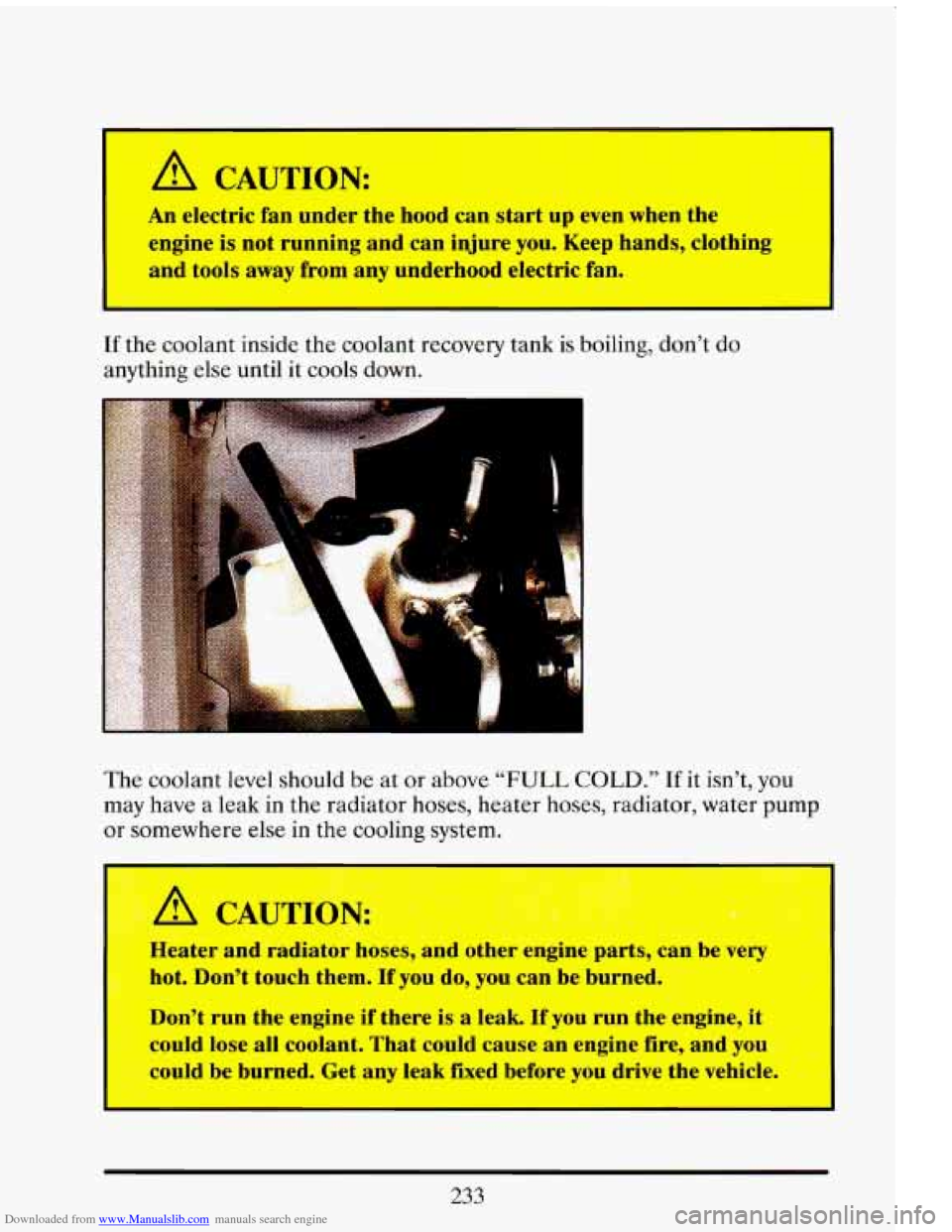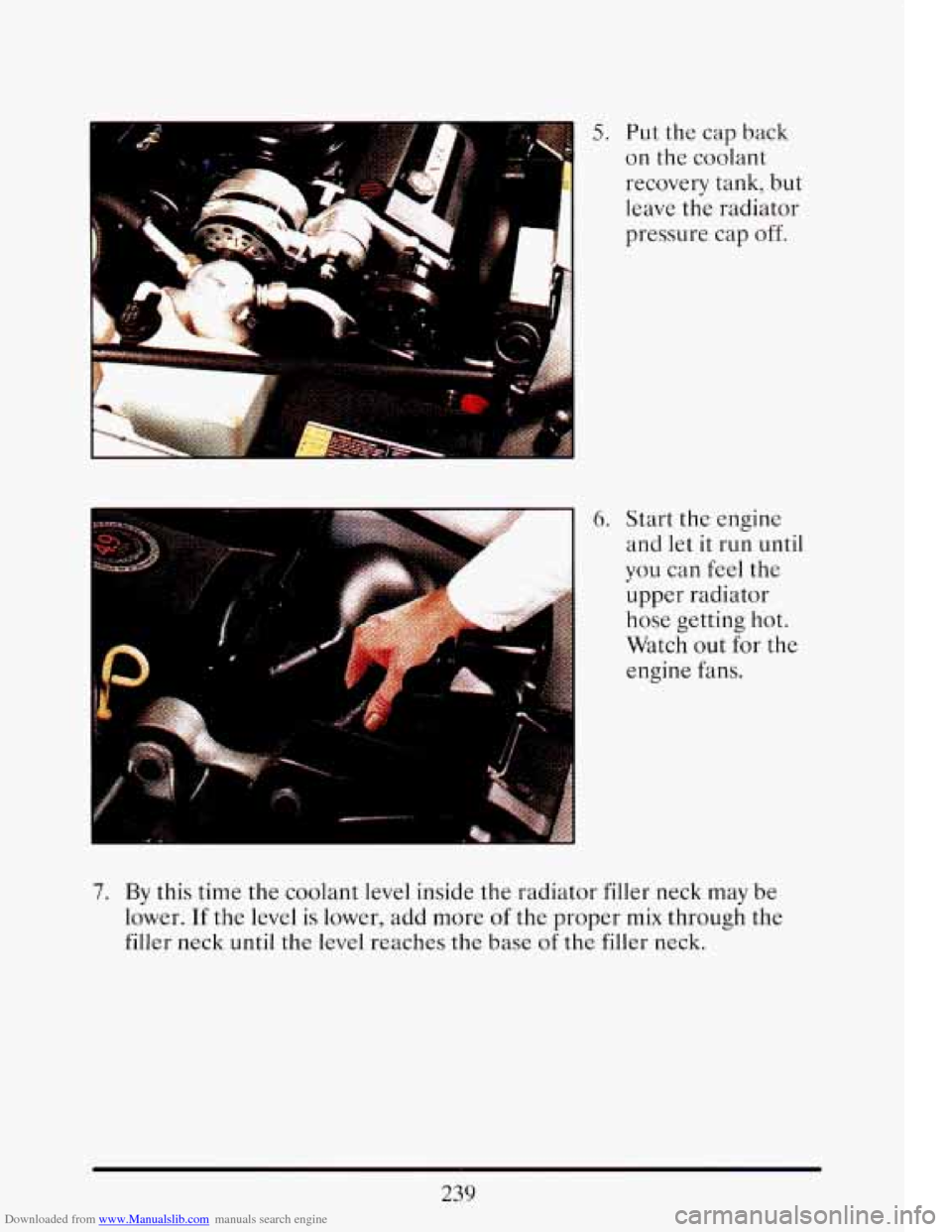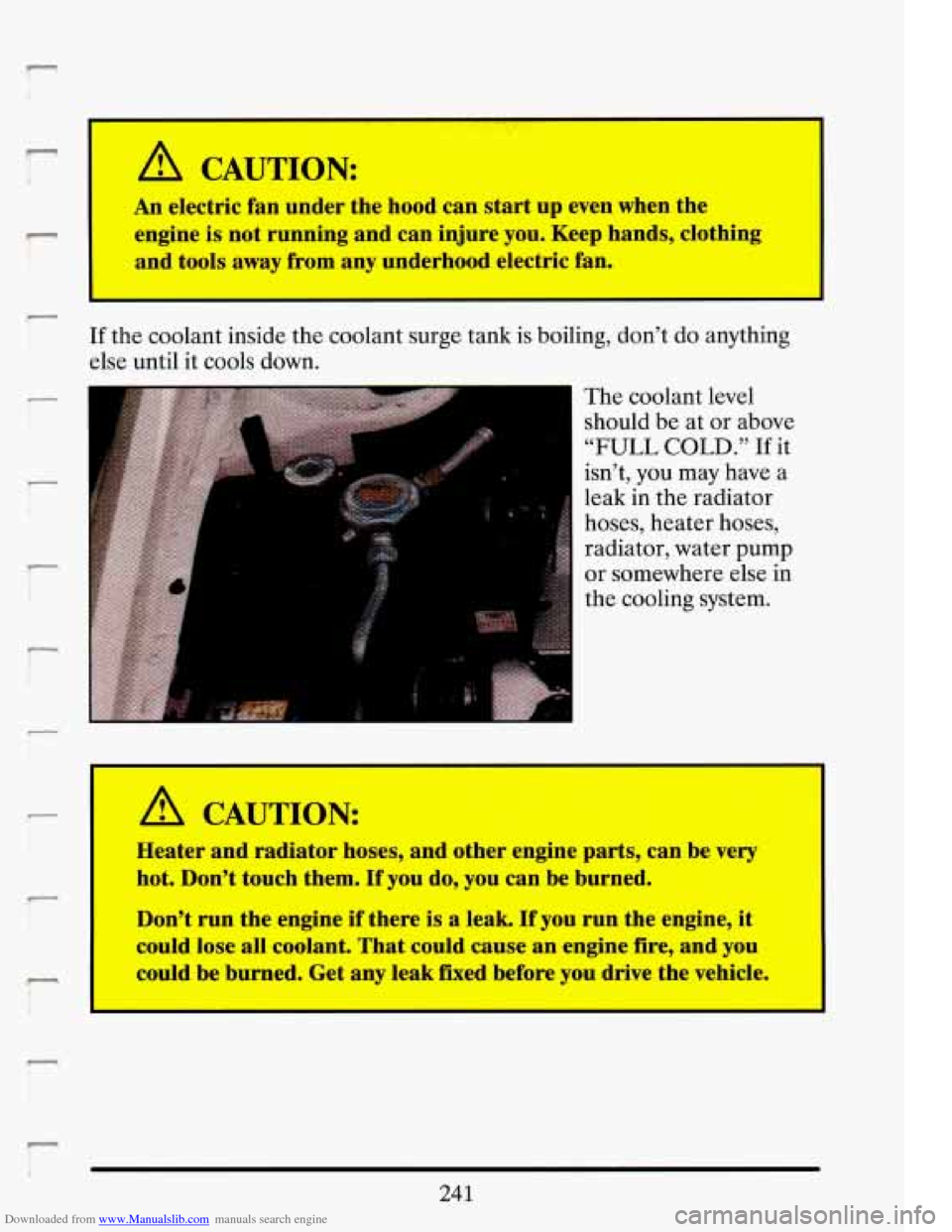1993 CADILLAC ELDORADO coolant level
[x] Cancel search: coolant levelPage 149 of 398

Downloaded from www.Manualslib.com manuals search engine CHANGE TRANS FLUID (Northstar Only)
This message will appear when it is time to replace the transaxle fluid.
See your maintenance booklet for the proper fluid and change i\
ntervals.
CHECK BRAKE FLUID
This message is displayed to inform the driver that the brake reservoir
fluid level
is low. Check the brake reservoir level and add as needed.
Have the brake system serviced by
a Cadillac technician as soon as
possible.
If the brake warning light is on, follow the directions in that
section.
CHECK COOLANT LEVEL (Northstar Only)
This message will appear when there is a low level of engine coolant.
Have the cooling system serviced by a Cadillac technician as soon as
possible.
CHECK FUEL GAGE
This message will appear when your fuel supply is less than 4 gallons and
your display is turned
off.
CHECK OIL LEVEL (Northstar Only)
This message will appear when your engine oil is approximately a quart
low. If this message is displayed, check the oil and add as needed.
CHANGE OIL SOON
This message will appear when your engine oil is less than 10 percent or
the mileage since the last oil change is more than 6750 miles.
CHANGE ENGINE OIL
135
This means that the life of your engine oil has expired and it should be
changed immediately. See engine
oil and filter recommendations in the
Maintenance Schedule. After an
oil change, the Oil Life Index must be
reset. See “Oil Life Indicator”
in the index on how to reset it.
Page 150 of 398

Downloaded from www.Manualslib.com manuals search engine ENGINE COOLANT HOT IDLE ENGINE
This message will appear when your engine coolant temperature is over
126°C
(248’F). To avoid added strain on a hot engine, turn off your
Climate Control system and stop and allow your vehicle to idle until it
cools down or the mcssage is removed. If it does not cool down, turn off
your engine and have it serviccd before driving it again. Severe enginc
damage can result from an overheated engine. See “Engine Overheating”
in the Index.
ENGINE HOT - A/C COMPRESSOR OFF
This message will appear when the Climate Control is in “Auto” or
Defrost and the engine coolant
is hotter than the normal operating
temperature.
To avoid added strain on a hot engine the air conditioning
compressor
is automatically turned off. When that happens, air
conditioned air is not delivered.
Tf the coolant temperature returns to
normal,
you must select “AUTO”, “DEFOG” or Defrost to return to a
normal
A/C compressor operation.
FUEL LEVEL VERY LOW
This message. serves as a warning that the fuel level in your tank is
critically low.
It means you should stop for fuel immediately.
LOW A/C REFRIGERANT - SERVICE A/C SOON
This message will appear when the A/C refrigerant is so low that it no
longer can cool well. This message shows that some of the refrigerant has
leaked out
of the system, and that the A/C needs recharging. If you do
not have it recharged,
the system may not cool at all.
CHECK WASHER FLUID
This message shows that the washer fluid reservoir is nearly empty.
REDUCE ENGINE POWER (Northstar Only)
This message will appear if the engine starts to cut cylinders to reduce
power, If this message is ever displayed have your vehicle serviced as soon
as possible.
136
Page 247 of 398

Downloaded from www.Manualslib.com manuals search engine I
A CAUTION:
An electric fan under the hood can start up even when the
engine is not running and can injure you. Keep hands, clothing
and tools
away from any underhood electric fan.
If the coolant inside the coolant recovery tank is boiling, don’t do
anything else until it cools down.
The coolant level should be at or above
“FULL COLD.” If it isn’t, you
may have
a leak in the radiator hoses, heater hoses, radiator, water pump
or somewhere else
in the cooling system.
I
Heater and radiator hoses, and other engine parts, can be very
hot. Don’t touch them. If you do, you can be burned.
Don’t run the engine if there is
a leak. If you run the engine, it
z;:s- could lose all coolant. That could cause an engine fire, and you
%-?7 ..- I could be burned. Get any leak fixed before you drive the vehicle.
2 . Y -- I
-
- .:.- .. .
.-I. * .C, . --
233
Page 248 of 398

Downloaded from www.Manualslib.com manuals search engine NOTICE:
Engine damage fro running: your
covered hv vow 1 rrant
wine withc bolant isn’t
If there seems to be no leak, check to see if the electric engine fans are
running. If the engine is overheating, both fans should be
running. If they
aren’t, your vehicle needs service.
How to Add Coolant to the Coolant Recovery Tank
If you haven’t found a problem yet, but the coolant level isn’t at or above
“FULL COLD,” add a 50/50 mixture of clean water (preferably distilled)
and
a proper antifreeze at the coolant recovery tank. (See “Engine
Coolant’’
in the Index for more information about the proper coolant
mix.)
,/!1 CAUTIO
Adding only plain water ur coomg syscem can De
dangerous. Plain water, or some other liquid like alcohol, can
boil before the proper coolant mix
will. Your vehicle’s coolant
warning system
is set for the proper coolant mix. With plain
water
or the wrong mix, your engine could get too hot but you
wouldn’t get the overheat warning. Your engine could catch
fir6
and you or others could be burned. Use a 50/50 mix of ( m
water I d a Droner antifreeze
I
I
NOTICE:
1
In cold weather, water can L Jeze and crack the engine, radiato,,
heater core and other parts. Use the recommended coolant.
234
Page 253 of 398

Downloaded from www.Manualslib.com manuals search engine 5. Put the cap back
on the coolant
recovery tank, but
leave the radiator
pressure cap off.
6. Start the engine
and let it run until
you can feel the
upper radiator
hose getting hot.
Watch out for the
engine
fans.
7. By this time the coolant level inside the radiator filler neck may be
lower.
If the level is lower, add more of the proper mix through the
filler neck until the level reaches the base
of the filler neck.
239
Page 255 of 398

Downloaded from www.Manualslib.com manuals search engine T
I A CAUTION:
An electric fan under the hood can start up even when the
engine
is not running and can injure you. Keep hands, clothing
and tools away from any underhood electric fan.
If the coolant inside the coolant surge tank is boiling, don’t do anything
else until it cools down.
r
/1
I
r
I-
= The coolant level
~ should be at or above
“FULL COLD.” If it
isn’t, you may have a
leak in the radiator
hoses, heater hoses,
radiator, water pump
or somewhere else
in
the cooling system.
A CAUTION:
Heater and radiator hoses, and other engine parts, can be very
hot. Don’t touch them.
If you do, you can be burned.
Don’t run the engine if there is a leak.
If you run the engine, it
could lose all coolant. That could cause an engine fire, and you
could be burned. Get any leak fmed before you drive the vehicle.
241
Page 256 of 398

Downloaded from www.Manualslib.com manuals search engine If there seems to be no leak, check to see if the electric engine fans are
running.
If the engine is overheating, both fans should be running. If they
aren’t, your vehicle needs service.
How to Add Coolant to the Coolant Surge Tank
If you haven’t found a problem yet, but the coolant level isn’t at or above
“FULL
COLD,” add a 50/50 mixture of clean water (preferably distilled)
and a proper antifreeze at the coolant recovery tank. (See “Engine
Coolant” in the Index for more information about the proper coolant
mix.)
I
A CAUTION:
Adding only plain water to your cooling system can be
dangerous. Plain water, or some other liquid like alcohol, can
boil before the proper coolant mix will. Your vehicle’s coolant
warning system is set for the proper coolant mix. With plain
water or the wrong mix, your engine could get too hot but you
wouldn’t get the overheat warning. Your engine could catch fire
and you
or others could be burned. Use a 50/50 mix of clean
water -nd
a proper antifreeze.
242
Page 260 of 398

Downloaded from www.Manualslib.com manuals search engine 4. Put the cap back on
the coolant surge
tank.
5. Start the engine and as the engine runs the coolant will circulate
through the cooling system. Any air that was introduced while adding
coolant will purge itself and rise to the top of the surge tank.
If the
“ENGINE COOLANT LOW” message does not appear on the
Driver Information Center, coolant is at the proper
fill level. If an
“ENGINE COOLANT LOW” message does appear, repeat steps
1
through 4 or see your dealer.
IFA TIRE GOES FLAT
It’s unusual for a tire to “blow out7’ while you’re driving, especially if you
maintain
your tires properly. If air goes out of a tire, it’s much more likely
to leak out slowly. But if you should ever have a “blowout,” here are a
few tips about what to expect and what to do:
If a front tire fails, the flat tire
will create a drag that pulls the vehicle
toward that side. Take your foot off the accelerator pedal and grip the
steering wheel firmly. Steer to maintain lane position, then gently brake
to
a stop well out of the traffic lane.
A rear blowout, particularly on a curve, acts much like
a skid and may require
the same correction you’d use in a skid. In any rear blowout, remove your
foot from the accelerator pedal. Get the vehicle under control by steering the
way you want the vehicle
to go. It may be very bumpy and noisy, but you can
still steer. Gently brake to
a stop, well off the road if possible.
If your tire goes flat, the next section shows how to use your jacking
equipment to change a flat tire safely.
246